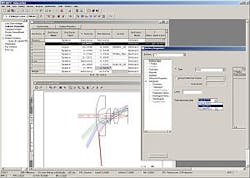CODE V 10.2 introduces improved ray tracing algorithms for designing optical systems with extreme aspheres, hyper-hemispherical fields of view, and highly tilted components. A simplified custom macro-writing feature allows users to specify any appropriate external program as the default text editor. Expanded graphical output options, file conversion enhancements, an updated status bar, an expanded tabular listing of surface-by-surface transmission values, and built-in performance metrics have been added.
Optical Research Associates
Pasadena, CA
[email protected]
------
PRESS RELEASE
CODE V 10.2 Delivers Enhanced Ease of Use
CODE V 10.2, the newest release of the premier optical design software from Optical Research Associates (ORA), delivers a number of enhancements that simplify its use and provide greater flexibility for users. For example, CODE V 10.2 introduces improved ray tracing algorithms that increase robustness when designing optical systems with extreme aspheres, hyper-hemispherical fields of view (fisheye lenses), and highly tilted components. Most importantly, these new algorithms maintain the fast ray tracing speeds for which CODE V is well known. Plus, custom macro writing is simplified in CODE V 10.2, which now empowers users to specify any appropriate external program as the default text editor.
CODE V 10.2 delivers expanded graphical output options, including the use of smarter defaults for producing optical system drawings with the View Lens feature. File conversion enhancements allow all CODE V plots to be directly saved in a number of common graphics file formats (including BMP, GIF, JPEG, PNG, and TIFF), saving users time when creating system images for presentations or further analysis.
CODE V data display is improved with an updated status bar, which can show substantially more user-selected system parameters than in the past. Additionally, a brief description of each item in the status bar is shown on mouseover, which is displayed in the language you have selected for CODE V operation. The tabular listing of surface-by-surface transmission values (Transmission Analysis feature) has been expanded to explicitly list Fresnel losses, absorption, diffraction efficiency and filter interferograms, thus allowing users to more clearly identify individual transmission contributions.
CODE V 10.2 also makes solving tolerancing problems even easier with an expanded range of built-in performance metrics. These metrics can be used as is or customized, providing users with unlimited flexibility for evaluating system performance and manufacturability.
With over 45 years of success as an industry leader, Optical Research Associates (ORA) is committed to delivering innovative solutions to the optics industry. With its CODE V and LightTools software products, ORA is the world’s leading developer of optical software. ORA is also the largest independent supplier of optical design and illumination engineering services, with more than 4,700 completed projects since the company was founded in 1963.
For more information, contact David Brown, Vice President of Sales and Marketing, Optical Research Associates, 3280 E. Foothill Blvd., Pasadena, CA, 91107, telephone 626 795-9101, FAX 626-795-0184. Email: [email protected], Web: http://www.opticalres.com.
